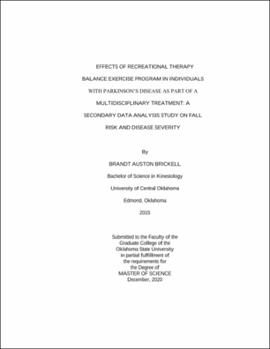| dc.contributor.advisor | Passmore, Tim | |
| dc.contributor.author | Brickell, Brandt Auston | |
| dc.date.accessioned | 2021-05-25T20:42:32Z | |
| dc.date.available | 2021-05-25T20:42:32Z | |
| dc.date.issued | 2020-12 | |
| dc.identifier.uri | https://hdl.handle.net/11244/329988 | |
| dc.description.abstract | INTRODUCTION: Parkinson's disease (PD) is a neurodegenerative disease which produces motor symptoms that increase the fall risk those individuals. This secondary data analysis studies what impact does a 16-week dual treatment featuring Recreational Therapy guided Balance Training and Speech Pathologist guided LOUD Crowd® treatment session have on an individual's fall risk and disease severity. | |
| dc.description.abstract | REVIEW OF LITERATURE: Limited research has been conducted on the benefits of a Recreational Therapist led group exercise intervention for this population. Research has shown positive outcomes with exercise with participants who have PD such as improved functional mobility, balance, strength, gait performance, and improving scores on PD rating scales. Research into community-based programming has been found to be beneficial for geriatric populations, including those with PD and other special populations. Specific research into group exercise with individuals with PD has found to possibly produce benefits in balance, gait, strength, and dual-task performance. | |
| dc.description.abstract | METHODOLOGY: Weekly 90 minute co-treatment sessions, with each treatment being 45 minutes long. Recreational Therapy focus was to maintain and improve balance, postural stability, and overall physical functioning while the Speech Pathology focus was to maintain and improve voice production, voice volume, and cognitive functioning. Baseline data was collected and compared to post data at the end of the 16-week program. | |
| dc.description.abstract | FINDINGS: Pre and Post differences in BBS Fall Risk, z=-.271(p=.786) and H&Y Scale, z=-.557(p=.577) and median differences of -0.0333 (BBS Fall Risk) and -0.1667 (H&Y Scale). No significance was observed in statistical analysis. | |
| dc.description.abstract | CONCLUSION: PD is a neurodegenerative disease with an average of 2-3 years per stage on the H&Y Scale. Results support the usage of recreational therapy to deliver treatment options that could complement existing pharmacological and behavior modification treatments for those diagnosed with PD. No significant change with PD population should be view positively and results highlight the need for longitudinal studies of similar methodology to observe long term effects against average progression of PD. | |
| dc.format | application/pdf | |
| dc.language | en_US | |
| dc.rights | Copyright is held by the author who has granted the Oklahoma State University Library the non-exclusive right to share this material in its institutional repository. Contact Digital Library Services at lib-dls@okstate.edu or 405-744-9161 for the permission policy on the use, reproduction or distribution of this material. | |
| dc.title | Effects of recreational therapy balance exercise program in individuals with Parkinson's disease as part of a multidisciplinary treatment: A secondary data analysis study on fall risk and disease severity | |
| dc.contributor.committeeMember | Lindenmeier, Donna | |
| dc.contributor.committeeMember | Bateman, Michelle | |
| osu.filename | Brickell_okstate_0664M_16905.pdf | |
| osu.accesstype | Open Access | |
| dc.type.genre | Thesis | |
| dc.type.material | Text | |
| dc.subject.keywords | balance | |
| dc.subject.keywords | disease severity | |
| dc.subject.keywords | fall risk | |
| dc.subject.keywords | functional mobility | |
| dc.subject.keywords | parkinson's disease | |
| dc.subject.keywords | recreational therapy | |
| thesis.degree.discipline | Leisure Studies | |
| thesis.degree.grantor | Oklahoma State University | |
